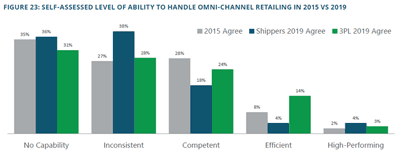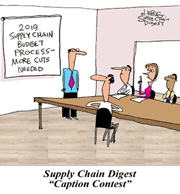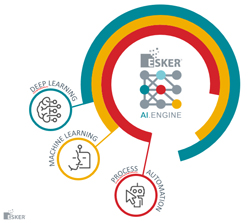Highlights of the Annual 3PL Study Part 2
For the 23rd consecutive year, my friend Dr. John Langley of Penn State University has led the annual Third Party Logistics Study.
Last week I summarized the main part of the report that pulls together quite a bit of survey data from shippers and 3PLs, including the famous "IT Gap" that never seems to go away. (See Highlights of the Annual 3PL Study.)
This week, I include a summary of most of the special topic sections, some frankly driven by report sponsor interests but nevertheless generally worth the read.
| GILMORE SAYS: |
For all the advancement and growth in omnichannel supply chains, we are not at the beginning of the end, but rather the end of the beginning, as Winston Churchill famously said.
WHAT DO YOU SAY?
Send us your
Feedback here
|
First, I'll take a look at the discussion of "keeping the supply chain alive and nimble" - that certainly sounds like a better place to be than "dead and rigid."
The report notes the inherent trade-offs between efficiency and agility in supply chain.
"The challenge of crafting a state-of-the-art supply chain is balancing the need to reduce costs while improving agility in an ever-changing marketplace," the report notes.
That's the goal but where to set than balance and how to improve both capabilities at the same time are the daunting questions.
The report hints that more companies are moving the dial a bit more in the agility direction, but notes 39% of survey respondents said they haven't made changes to increase their inherent agility over the past five years and 15% more reported decreasing supply chain nimbleness in favor of reducing costs.
I will note parenthetically that while increasing agility is good, not many companies will pursue more flexibility if it means costs will go up.
This discussion in this section then rather abruptly jumps to some commentary on current transportation challenges in terms of constrained capacity and rising costs.
The report touts the role of 3PLs in reacting to these challenges, and I agree with the comments that logistics service providers may have large shipper bases that can be evaluated for synergies across those companies.
It was noted, for example, that report sponsor Penske Logistics is utilizing data scientists to look at the $4 billion of managed freight it handles to find natural pairings that would optimize the logistics flows.
And while not exactly connected to agility, it's worth including the report reminder to differentiate between rates and costs.
"Large shippers have their procurement departments and they are measured on rate and rate improvement," the report notes.
"Today it is about mitigating rate increases, and that in itself changes the conversation and drives the rate versus cost discussion," a Penske exec is quoted as saying.
Technology clearly can play a key role in increasing agility. The survey says a high percentage of both 3PLs and shippers plan to invest in supply chain visibility/control towers within the next two years. More than half of shippers (59%) and 3PLs (58%) are investing in predictive analytics.
Next, I will take a look at the "last yard" special topic. While "last mile" challenges have been highly discussed over the past decade with the growth of ecommerce and Amazon's relentless focus on reducing lead times, the report introduces the new (to me at least) concept of the last yard. What does that mean?
It involves "what happens to a shipment once it is delivered to a customer or consumer, and then how it is routed to a specific location where it may be needed or used."
And this is not just somehow a more granular aspect of efulfillment. The report cites one example as being the movement of repair parts needed for a manufacturing process from the receiving dock to the manufacturing location. Another last yard scenario is "movement of consumer purchases from the point-of-central delivery to the point-of-use."
Not exactly sure what that means, but I will roll with it for now.
The main point seems to be that even if the rest of the supply chain does its job in terms of right product in the right place at the right time, it can all go for naught if the last yard execution is inefficient. Another way to look at it is the opportunity to add value from last yard innovation.
Some examples of the latter include say tests by Amazon and others to not only deliver to a customer's home, but also to place groceries directly into refrigerators or pantries. Or sophisticated sequencing of parts or assemblies from suppliers to manufacturing lines.
In one of the trends called out relative to last yard, the report notes, is the "increase in value and criticality of many shipments, with examples including medical equipment and supplies, repair/replacement parts, high-priority deliveries for senior executives, and a number of other types of shipments that must be delivered when and where they are needed to avoid organizational problems."
The report notes the increased interest in self-service solutions to last yard challenges, most notably with the locker concept being rolled out by a number of retailers and logistics companies, and thoughts that approach might be extended beyond just ecommerce consumer fulfillment.
This whole section can be adequately summarized in this statement from the report: "The central idea is that supply chains do not end at the receiving dock or the central point where shipments are delivered but at the point of use where the intended value is actually created."
Will the term "last yard" catch on? In some sectors I suspect, but probably not broadly, even if very relevant in some scenarios and a potential focus for innovation.
The report next takes a fresh look at omnichannel commerce. It was last a focus topic in the 2015 report, and thus ripe for some fresh perspective and survey data in this rapidly changing domain.
Perhaps surprisingly, most shippers and 3PLs rate themselves as not very mature in omnichannel capabilities. As shown in the chart below, only percentages in the low single digits rate themselves as "high performing" in this area.

See Full Image
The highest percentage - 38% - said they are inconsistent and 36% said they had no capability. Just 18% of shippers rated themselves as competent.
I will note, however, this could be because, as an example, chemical company responses were included in the data pool that naturally pulled down the overall average. But will also observe that I have recently spoken several 3PLs that are significant firms in the market but as yet really don't offer much in the way of efulfillment services.
The report asked shippers and 3PLs to rate top omnichannel challenges, and the results seem about right. The top issue was flexibility/last-minute changes to orders, which was cited by 42% of shippers and 40% of 3PLs, followed by inventory visibility (35% of shippers, 20% of 3PLs), inventory control (35% of shippers and 30% of 3PLs), and order management (35% of shippers, 24% of 3PLs).
My take: for all the advancement and growth in omnichannel supply chains, we are not at the beginning of the end, but rather the end of the beginning, as Winston Churchill famously said.
Lastly, there was a section on data sharing between shippers and 3PLs - an interesting topic indeed.
The report notes the many steps and functions involved from a shipper first putting together an RFI type document for a new 3PL selection process through that selection and operational start-up, and how information flow is the lifeblood of a successful end-to-end process.
An analogy was made to a relay race, with information as the baton - if it is dropped, even partially, anywhere along the way it will lead to an unsatisfactory result.
Among respondents, 36% of shippers and 35% of 3PLs agreed that there were opportunities to improve the sharing of insight and data collected by 3PL sales teams with their account management functions. Also, 37% of shippers and 35% of 3PLs agreed there was a need for improving the hand-off of bid, RFP and tender data with solution design/delivery teams.
"There are real and lasting consequences to 3PLs that don't make data sharing a priority across their commercial operations," says Chuck McDaniel, a 28-year veteran of Procter and Gamble's supply chain group. "It would seem irresponsible not to explore the innovation that we're seeing from Silicon Valley, that's transforming the efficiency of the RFP process."
I am not sure what that new technology is - but I will find out.
I am out of space. Again, the full report available for free download with registration here. Would welcome your thoughts.
Any reaction to this data from the 3PL report? Let us know your thoughts at the Feedback section below. |



![]()

![]()

![]()














